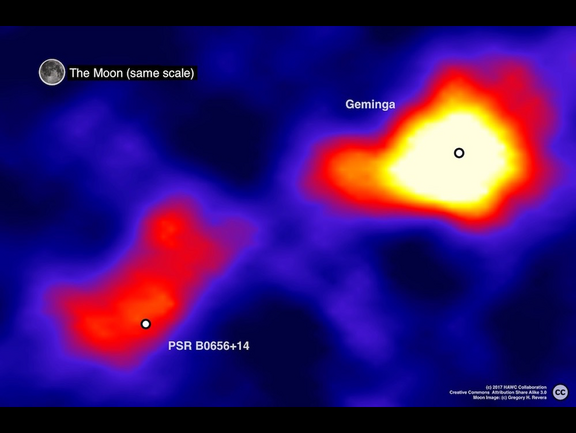Despite a century of cosmic ray studies, we still know rather little about their origin, and perhaps even more surprising, we don't understand the way how they propagate in the Milky Way, especially at the first epochs when they leave their acceleration sites and enter into the interstellar medium.
Cosmic rays are charged particles travelling at very close to the speed of light, following curved trajectories in the magnetic fields that are ubiquitous in the Universe. On very large scales the motion of cosmic rays may start to look like a random walk and the process can be modelled as a type of diffusion. The open questions include: is this diffusion picture always the right one? Is the diffusion speed the same in all parts of the Milky Way?
Researchers at MPIK are deeply involved in this quest to understand cosmic ray propagation and major steps forward have been made recently via observations of ‘halos’ of energetic electrons at sites of particle acceleration around pulsars. A recent article in Nature Astronomy discusses the exciting prospects in this area [1].
Pulsar wind nebulae (PWN) are powerful particle accelerators, powered by the rapid rotation of recently formed neutron stars. For a long time PWN were thought of by many as closed bags of high energy particles, but recent advances in our observations have allowed us to see accelerated particles in the process of escaping from their sources and out in to the interstellar medium. After a breakthrough measurement made with the HAWC observatory in Mexico, which revealed particles diffusing much more slowly than expected [2], we have worked on understanding the presence of halos around the many known TeV PWN [3,4].
The future projects SWGO and CTA will be able to revolutionise our understanding of cosmic ray transport using halos around pulsars and their nebulae as well as other systems.
Original publications:
[1] Gamma-ray haloes around pulsars as the key to understanding cosmic-ray transport in the Galaxy, R. López-Coto, E. de Oña Wilhelmi, F. Aharonian, E. Amato, J. Hinton, Nature Astronomy, 14.02.2022, DOI: 10.1038/s41550-021-01580-0
[2] Extended gamma-ray sources around pulsars constrain the origin of the positron flux at Earth, HAWC Collaboration, Science358, 911–914 (2017), DOI: 10.1126/science.aan4880
[3] Halo fraction in TeV-bright pulsar wind nebulae, G. Giacinti, A. M. W. Mitchell, R. López-Coto, V. Joshi, R. D. Parsons, J. A. Hinton, Astronomy&Astrophysics 636, A113 (2020), DOI: 10.1051/0004-6361/201936505
[4] Do the Geminga, Monogem and PSR J0622+3749 γ -ray halos imply slow diffusion around pulsars? S. Recchia, M. Di Mauro, F. A. Aharonian, L. Orusa, F. Donato, S. Gabici, S. Manconi, Physical Review D 104, 123017 (2021), DOI: 10.1103/PhysRevD.104.123017
